A wine cellar with your own hands in a private house has been made for quite a long time. This design is especially advantageous in the southern regions of the country.
The wine of the local cellars is popular with visitors and also gives income. Therefore, its storage is of particular importance.
We will consider the construction of a wine cellar in this article, you will have the opportunity to see the entire process of work on video and photos, and instructions will be given for performing this work.
Recommendations of a wine cellar in a private house
A wine cellar with your own hands in a private house is not much different from a simple one. It’s just worth using slightly different insulation here.
That is, the finish looks different, so it is worth knowing these features before starting construction. And only then do the work.
- The wine cellar in a private house for wine should be decorated with closed-pored materials. They will not allow condensation to accumulate and will maintain the desired temperature. In this case, a layer of about 10 cm should be applied;
- The walls should also be treated with antiseptics, which are available for free sale. They will not allow the formation of fungus and mold, which may affect the tightness of the plugging, the corks will be damaged and the wine will be oxidized;
- The wine cellar should also be equipped with a high-quality entrance door with your own hands. It should be tightly closed. Here it is necessary to apply additional seals that will make the entrance sufficiently sealed.
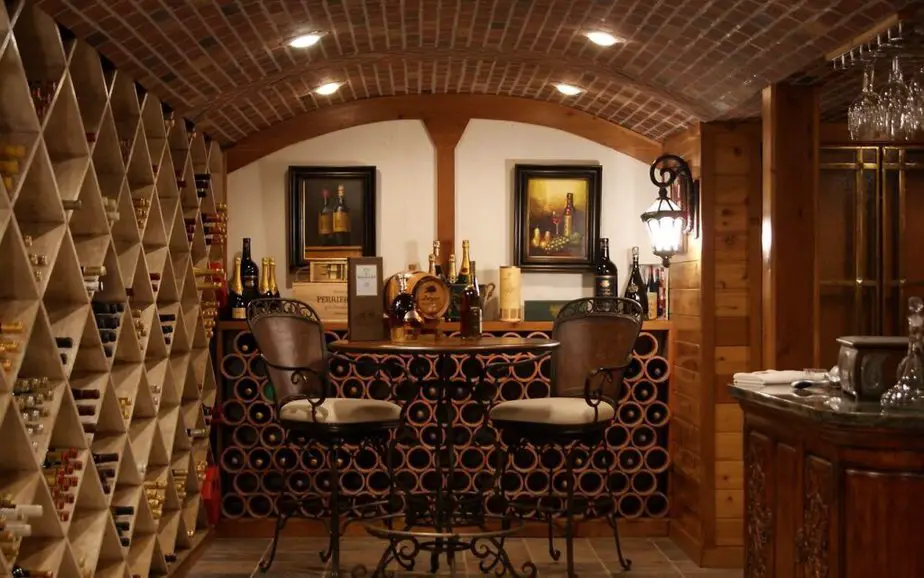
Attention: Do not make the door wide, it will simply increase the air exchange, which will adversely affect the wine.
- The floor in the wine cellar does everything differently. There are many different opinions here, everyone considers his own to be the only correct one.
One thing is said that the floor can be made with tiles, others think that it should only be made of wood. There is also an opinion that it is best to make a gravel filling, which will prevent the formation of condensate.
Here you have to decide for yourself what is more suitable for you. But one thing is clear, the finish should be natural. No new chemical materials will work; - The cellar for homemade wine will also need to be equipped with racks, which should be given special attention (see Racks for the cellar: recommendations for assembling structures). The best manufacturers make them from natural materials, for example, from clay, which is subject to firing.
Some people use cement mortar in the manufacture, but many prefer ordinary clay bricks; - A wine cellar in a private house should also be equipped with a decent vault. To do this, it is best to use lime materials.
They make self-regulation of humidity and contribute to the long-term storage of the product. In this design, fluctuations in temperature and humidity are excluded;

Attention: When arranging a place for storing the product, it should be remembered that the bottles are stored only in a horizontal position. In this position, the plug is constantly wetted and this protects it from drying out.
- Bottles should never be turned over and subjected to fluctuations. Just during storage, a precipitate falls out in them and it can not be mixed with wine.
Therefore, cellars are not built even near railway tracks. You won’t even be able to find a washing machine nearby, but of course, who appreciates the sophistication of this drink;
Attention: The wine cellar is made according to these recommendations. You should start making a wine cellar with your own hands if you follow these recommendations and then you will understand the taste of real wine.
Various installations for the wine cellar will help create a microclimate in the room, but remember that everything is better to do naturally. And the price of the design will then be reduced.
It is better to do it qualitatively once than to correct mistakes all the time with the help of climate control systems.
What to pay attention to when building a wine cellar
- Before building a wine cellar, you need to conduct a thorough analysis of the location where the construction will begin
- The lowlands are not suitable, since precipitation and meltwater accumulate in these areas.
- Check the hydrogeological parameters of the land plot, as the risk of running into groundwater is not excluded. They should lie deeper than the floor level by at least 1 meter, and even more, is better.
- If the site is located near water bodies, then do not forget about the annual flood. An increase in the level of meltwater in a river or lake can cause flooding of a wine cellar in a private house.
- Placing a wine cellar with your own hands directly under the buildings, it is better to design directly with the main building.
- To prevent temperature changes inside, the cellar is built away from kitchens, boiler rooms, and baths.

As a matter of first importance, settle on a spot for the future basement. Wine is best put away underground, and your basement or storm cellar ought to be found precisely in the city, else you can disregard the fundamental temperature system. Simultaneously, the spot ought not to be situated on a marsh, in any case, precipitation will start to collect in the storm cellar.
There are no reasonable size limitations – you generally need to continue from your requirements and the extent of creation. For instance, on the off chance that you would simply prefer not to save a couple of ounces of custom-made wine for your utilization, yet you have an entire assortment in your arrangements, then, at that point, you should make room for no less than 25 m2. The base is 10 m2.

- Wine cellar with your own hands
It would be nice if your wine cellar is located under some kind of outbuilding. This is a very profitable solution because it can save space and, in some cases, facilitate access to the basement.
When choosing a place, the level of groundwater passage is of great importance.
They must be at least one meter below the floor.
The water depth is best checked by the water level in wells and wells on the site during heavy rains.
Wine cellar in a private house
At times, it is as yet conceivable to put a wine basement under the house. Be that as it may, for this situation, the basement ought to be considered and laid as of now at the phase of building the house and pouring the establishment. Having a wine basement directly in the house can extraordinarily astonish visitors and appropriately formerly companions, yet this isn’t generally a smart thought.
Recollect that a specific temperature should be kept up within the basement. It is distinctive for each kind of wine. By and large, the storm cellar ought to be 13-14 degrees. On the off chance that the inclination goes to the side beneath this imprint, the aging cycles will fundamentally diminish, which will contrarily influence the quality and speed of wine creation. If higher, the wine will rapidly weaken.

Fluctuations in the temperature in the wine cellar can lead to the deformation of the plugs. The air will begin to penetrate the vessels, and the wine will quickly deteriorate.
To avoid this, first of all, do not build a basement under the bath or kitchen. Also, beware of various vibrations, which place the cellar away from the roads.
Furthermore, to orchestrate a wine basement in a private house, you should load up on warming frameworks that will assist with keeping up with the ideal temperature system. Presently there are a considerable amount of climate control systems for a wine basement that can fulfill a winemaker with practically any pay.
From the abovementioned, another condition for the plan of a wine basement consistently follows – you should direct power there to control the forced air system. Coincidentally, it will likewise be helpful for lighting.
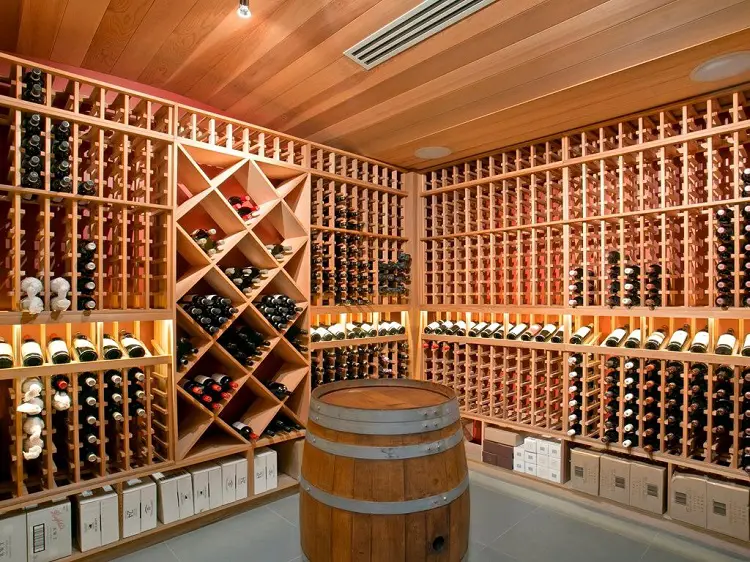
Concerning mugginess, it is important to keep 60-70%, you can do a little less, but not more. With higher moistness, the plug endures, and this, as we probably are aware, straightforwardly prompts the waste of the beverage. Moreover, at high moistness, different microorganisms, shapes, greeneries, or organisms start to show up.
To keep up with dampness, utilize a split framework.
Deal with great warm protection. For protection, it is smarter to utilize extended polystyrene, and with it entering waterproofing. It is applied with a roller in two layers. For waterproofing, we can suggest that Penetron is sold as a powder and is weakened in water before use. Guidelines are appended. After applying it, we fix the protection on the dividers. Styrofoam is the least demanding to stick promptly on the dividers.
Wine cellar with your own hands and its humidity
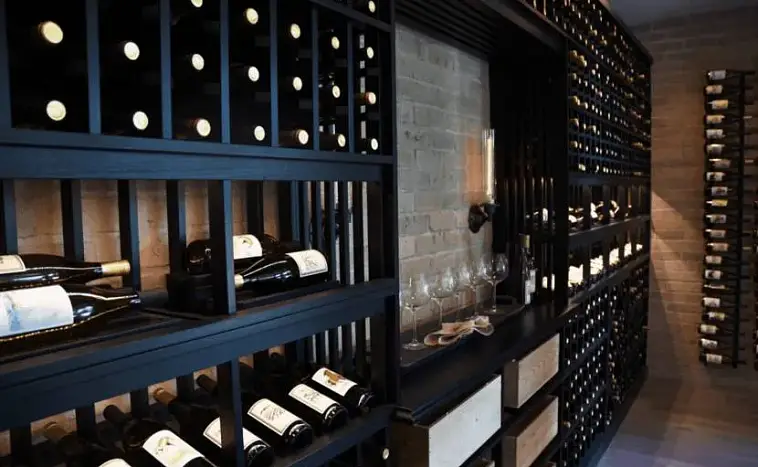
60-75%. In this reach, the mugginess boundaries are ideal for such a room. Expanding this level will cause the presence of form. Leaving the ordinary reach the descending way will prompt dry air and oxidation of the beverage.
Frequently, even a family-forced air system isn’t sufficient to make and keep up with the ideal microclimate. The acquisition of specific environmental control hardware is required. Such gear can be of two designs:
- Independent devices that can be easily removed, mounted, and moved.
- Centralized climate systems. They are installed at the construction stage of the cellar.
Nuances of the layout of a wine cellar in a private house: what can the room be like

The wine basement is one of the wonderful seemingly insignificant details that make life more agreeable. It has since a long time ago stopped to be an out-of-this-world dream; the proprietor or even a little house can manage the cost of such a component of extravagance.
It is no incident that an ever-increasing number of proprietors are putting together their wine libraries. All together for the plan to succeed, assemble and prepare a capacity place as per the guidelines of assortment science, and they have been known for quite a while.
The main thing you need to explore is to pick a building site. A great many people are certain that containers of wine ought to be put away only in the cellar.
Truth be told, the wine extra space can likewise be situated on a superficial level; it is simply important to give the vital microclimate. Consequently, the wine assortment is set in better places:
- In the basement or semi-basement (in the basement) of houses and cottages.
- In one of the rooms of the house (for example, next to the kitchen).
- In the annex adjacent to the main dwelling.
- In a separate building outside the house.

Each solution has its advantages:
- A wine cellar in the basement or basement is the most convenient option. You will not have to take care of its appearance, and you will not have to leave the house on a cold winter (or rainy autumn) evening to enjoy a delicious bouquet of a drink.
- The wine cellar in the house is conveniently complemented by a tasting room. The room with a bar, chairs, and comfortable armchairs can be decorated in the style of a classic gentlemen’s club, or choose any other design.
- An extension outside the house will become an exit if the house does not have a basement, or you do not have the opportunity to use it (for example, there are piles at the base, and there are too many of them).
- The removed wine cellar can be made invisible, or vice versa, an attractive element of the landscape, having decorated, for example, in the style of a hobbit house. It all depends on the characteristics of the site and its design.

Requirements for a wine cellar in a private house
A customary wine basement is put under a private structure and developed into the ground; its size relies upon the size of the house. In this way, in a huge ranch-style home, it isn’t hard to distribute 20-25 squares for a wine basement. This region will fit 2-3 thousand jugs, there is sufficient room for an ample barrel.
All the more regularly there are wine basements with a space of up to 10-12 squares. This site is more adequate for home use; it is adequate for a little private assortment. Whatever the size, it is important to give rigorously characterized conditions in the room, and this is accomplished by utilizing certain completing materials and establishment methods.
A wine cellar with your own hands and its walls
Ecological agreeableness is a significant basis while picking materials. Their dampness opposition and absence of smell are significant. For divider improvement, a covering of block, regular or fake stone, wood, and beautifying tiles is utilized.
Block and stone in the completion of the capacity

Particularly cautiously you should move toward the decision of a tree. It isn’t prescribed to utilize rocks with an articulated smell, for instance, pine or cedar. This choice will be fruitful for confronting a lounge, however in a wine basement the smell will be assimilated into the plug, and the wine will have a taste that is probably not going to improve it. The most ideal decision will be oak, whose wood has been utilized for quite a long time for the enhancement of wine basements.
Wooden components are treated with a clean to kill the presence of shape, which is hurtful to the substance of containers.
The dividers need top-notch protection and protection. The base thickness of the warm protection layer is 15 cm. To protect the capacity, use styrofoam, Penoizol; standard styrofoam is additionally appropriate. Before introducing the protection, the dividers of the room are fundamentally treated with a sterile.
Regular, breathable materials are utilized for the cladding. A well-known decision other than wood is a block or regular stone, particularly limestone or shell rock.

Floor and ceiling in the wine cellar of a private house
When the floors in-home wine basements were made of mud and loaded up with stream sand, in strong houses the floor was spread out with stone or block. Such completing strategies have not lost their pertinence right up until today. A layer of sand is a viable arrangement that permits you to keep away from the presence of wet spots on the floor from buildup drops tumbling from the roof. With the assistance of sand, you can manage the microclimate, saturating it in the warmth.
For completing the floor, non-slip clay tiles, marble, or other regular stone are utilized, sheets are laid or fine rock is poured. If your site has a high water table, and the actual dirt is wet, you can make a substantial floor, and, whenever wanted, cover it with similar ceramics.
The roof is made of wood, which is significant for noticing the temperature system. A layer of warm protection with a thickness of 10-12 cm is laid over the roof.

Equipment
They are attempting to plan the wine basement so that there is sufficient room for two utilitarian zones: stockpiling and tasting. For capacity, racks, racks, and wine cupboards are customarily utilized, which are introduced along with the dividers, and, if the room permits, they can likewise possess the focal part.
For the production of hardware, solid assortments of strong wood are utilized, impervious to decaying and having no articulated smell. Notwithstanding oak, debris, poplar, or maple are utilized. The best decision for a wine bureau is viewed as oak or wild cherry; on a particular surface, the cut style looks great. On the off chance that the plan requires it, purchase a bureau with the impact of maturing.

If the wine shop is situated in the house, you can purchase a refrigerated wine bureau. There are models in various styles available, incorporating those adorned with wood. This bureau will squeeze into any inside and will safeguard the wine assortment because of the accompanying innovative arrangements:
- Thermal insulation panels maintain a stable temperature.
- Sensors monitor the required humidity level.
- Tinted windows protect from ultraviolet light, and shock absorbers from vibration
The racks make an unmistakable escort of the room. They have the type of multi-layered areas with straight or slanted modules. Solid and sturdy stockpiling frameworks are made of metal, however, most proprietors lean toward the exemplary wooden variant.
The length of one area doesn’t surpass 70-80 cm to stay away from avoidance. For bottles, slanted racks with a well-being side are given; for particularly important assortments, square (some of the time hexagonal or jewel–molded) cells are given. Significantly, the racks are versatile. Every once in a while, they should be taken out to dry and treated with a sterile.

Briefly about the main thing
A wine cellar in a private house is a charming addition that helps to make life more pleasant. It is regularly placed in the basement or basement, less often in the house itself or another structure.
The main ability of the room is to preserve the taste properties of wine; for this, the room must “be able” to maintain a certain temperature and humidity system. When arranging the pantry, environmentally friendly materials are used, which are impervious to high humidity and have no smell. They additionally prepare the supply and exhaust ventilation, install stationary entrances, free the room from excess heat

I joined Appartenville in February 2021 as a content editor. After studying English literature at university, I worked as an e-commerce website editor, content author, and purchasing intern for several independent luxury and lifestyle retail companies. My role at Appartenville combines my love, experience, and passion for the world of design and the desire to create inspiring written content. As for my personal style, I am a big fan of color and drawing, especially I like the pastel color scheme. I also enjoy discovering new trends, brands, and products, whether it’s fashion, interior design, or lifestyle my wish list for buying new things is endless.

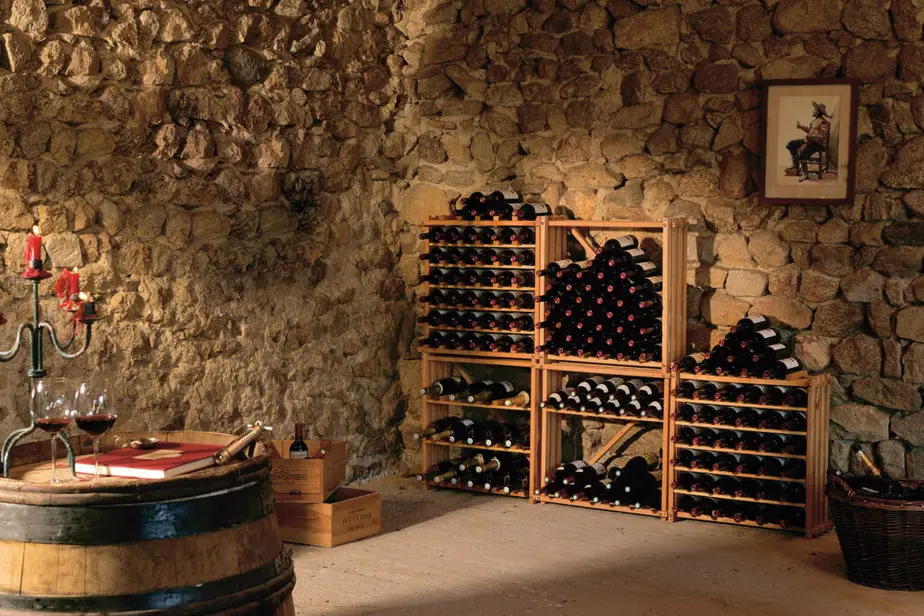

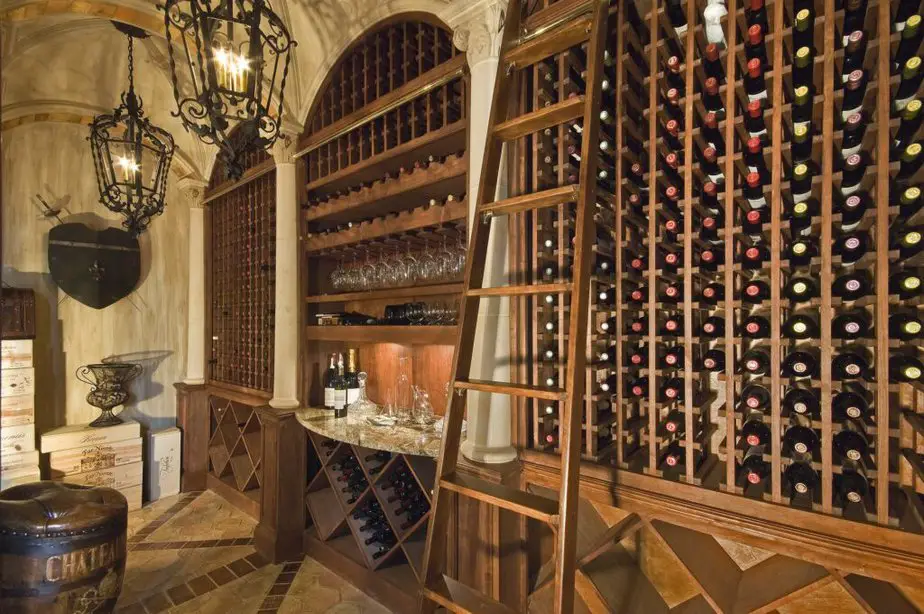

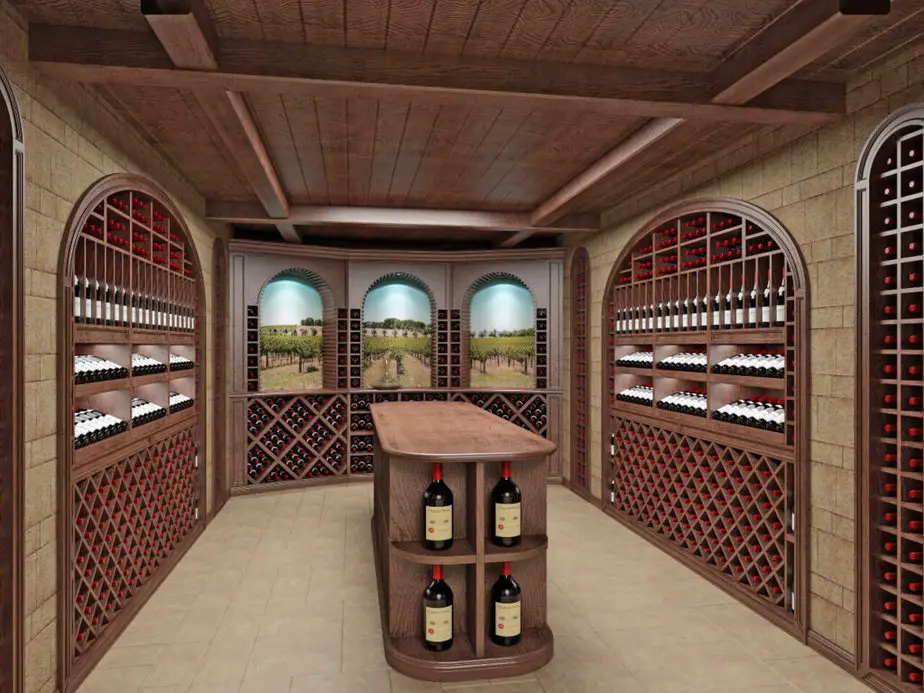
Leave a Reply